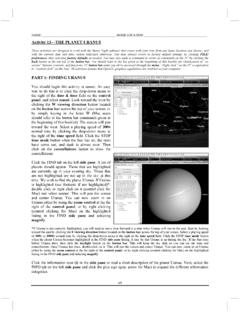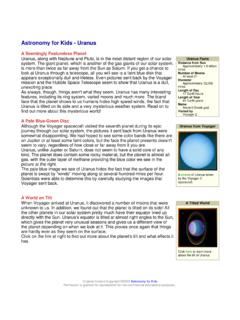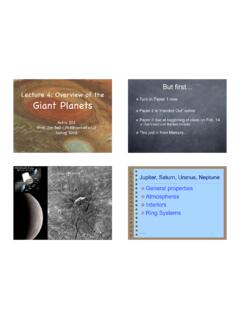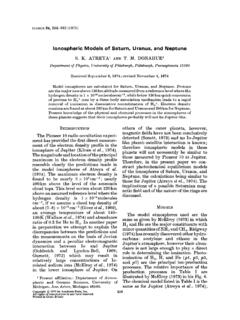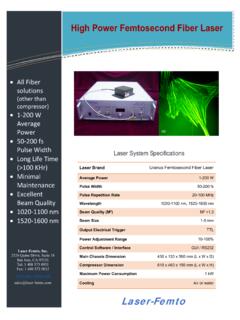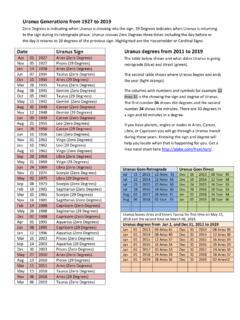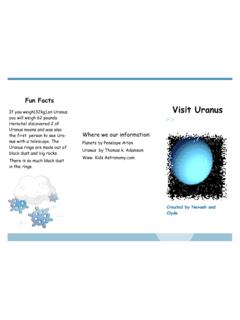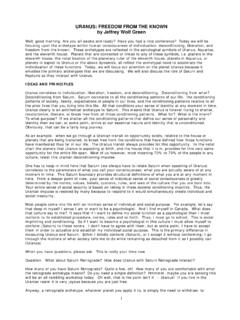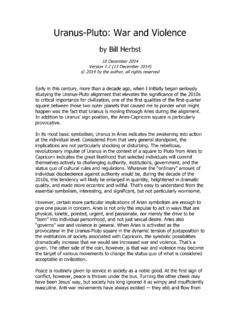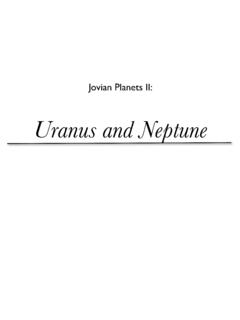Transcription of Ice Giant Science: The Case for a Uranus Orbiter
1 Hofstadter: Uranus OrbiterIce Giant Science: The case for a Uranus OrbiterMark HofstadterJet Propulsion Laboratory/California Institute of TechnologyReport to the Decadal Survey Giant Planets Panel, 24 August 2009 Voyager 1986 Hubble 1998 (Karkoschka)Keck 2003 (Hammel et al.)Hofstadter: Uranus OrbiterThis talk is based on an internal JPL study of missions to Uranus . Co-authors are listed White Paper, The case for a Uranus Orbiter , is currently being ContributorsScience Co-I s:Kevin BainesShawn BrooksLeigh FletcherA. James FriedsonRobert LockNeil MurphyGlenn OrtonRobert PappalardoNicole RappaportChristophe SotinDaniel WenkertRapid Mission Architecture Team:Tom Spilker (Study Lead)William SmytheRobert MoellerChester BordenErick SturmRobert MiyakePaul StellaRobert KinseyChuck BakerThis research was carried out at the Jet Propulsion Laboratory, California Institute of Technology, under a contract with the National Aeronautics and Space : Uranus OrbiterI) IntroductionII) The scientific importance of ice giantsIII) General results from our study of Uranus missionsIV) Specifics of a New Frontiers-class Uranus Interior MissionV) ConclusionsOutline of Today s TalkHofstadter.
2 Uranus OrbiterI) IntroductionII) The scientific importance of ice giantsIII) General results from our study of Uranus missionsIV) Specifics of a Uranus Interior MissionV) ConclusionsOutline of Today s TalkHofstadter: Uranus OrbiterWhat is the bulk composition and interior structure of the ice giants?This is the most important question to address, as it defines what an ice Giant is. It influences our understanding of The proto-planetary nebula (composition and dynamics), Planetary formation (how and where planets form), Thermal and chemical evolution of planets (heat flow, interior convection), Extra-solar Giant Science Questions (Page 1 of 4)Images HamiltonHofstadter: Uranus OrbiterWhere and how is the magnetic field generated?
3 The magnetic field is important for understanding Upper atmospheric composition and energy balance, The interior structure (conductive and convective regions), The dynamo generation Giant Science Questions (Page 2 of 4)Image courtesy F. BagenalHofstadter: Uranus OrbiterWhat is the nature of internal heat transport within Uranus ? Uranus is emitting essentially no internal heat, perhaps due to density variations inhibiting convection. This impacts Uranus Evolution, Interior structure and circulation, Atmospheric dynamics and composition, The dynamo generation Giant Science Questions (Page 3 of 4) / Absorbed / kg x 1010433 4642 472010 1405440 430W / m2 x 1011 NeptuneUranusSaturnJupiterInternal HeatBased on Guillot 2005 Hofstadter: Uranus OrbiterWhat is the nature of everything else about the ice giants?
4 The magnetosphere and its special solar wind geometry. The inclined dipole field maximizes the coupling between the solar wind and the magnetosphere. This is particularly true at Uranusnear equinox. The atmosphereThere are aspects of composition, temperature, chemistry, circulation, and variability only seen in the ice giants. Uranus extreme seasonal forcing is an example, or Neptune s Dark Spots. The satellitesThe size distribution and perhaps composition of native ice Giant satellites is different than gas-giants. The ringsThe particle size distribution and morphology of ice- Giant rings is different than the gas Giant Giant Science Questions (Page 4 of 4)Hofstadter: Uranus OrbiterWhy a Mission to an Ice Giant ?In the parameter space of all possible planets, Uranus and Neptune occupy a region we know very little about.
5 They have an important story to tell about planetary formation and evolution. Learning about them is particularly important if we are to understand extra-solar planetary ice Giant can serve as a model for this poorly-understood class of planet, and both have unique features worthy of major categories of objects in our solar system have a dedicated mission currently flying, except for the ice mid-sized mission launched to an ice Giant in the next decade is the only way to dramatically advance our understanding of these objects in our professional : Uranus OrbiterWhy Uranus Instead of Neptune? Uranus interior structure and internal heat flow are most challenging to our understanding of planetary formation and evolution, and better constrain our models.
6 Uranus is closer, allowing forShorter flight times (reduced cost and greater reliability),More sunlight (for imaging and power),Better ground-based supporting observations. Its atmosphere and satellites experience extreme seasonal forcing due to the systems 98 axial tilt. The uranian satellite system may be our solar system s only surviving example of an ice Giant system. It allows a scientifically compelling mission in our : Uranus OrbiterI) IntroductionII) The scientific importance of ice giantsIII) General results from our study of Uranus missionsIV) Specifics of a Uranus Interior MissionV) ConclusionsOutline of Today s TalkHofstadter: Uranus OrbiterThe JPL StudyLate last summer, we undertook a small study to explore the feasibility of a solar powered mission to Uranus .
7 Most results are relevant to nuclear powered missions as primary focus was on New Frontiers, but we also considered higher-cost options. We engaged JPL s Rapid Mission Architecture (RMA) process, which compliments the more familiar Team-X studies. RMA allows a much broader range of missions and architectures to be explored, but with less cost the same spacecraft approach, picking different b-planeaim points can yield very different orbits. One can give anearly -polar line of apsides, one 180 away from the firstgives a more nearly equatorial line of apsides. T he m orenearly equatorial case is easier to rotate and crank into anequatorial orbit. The apsidal offset angle, the angle betweenthe approach direction vector and the resulting orbit s line ofapsides , is roughly constant.
8 For some b-plane aim pointsthere is an issue with ring collision are greatlyforeshortened for are actually muchfarther : Uranus OrbiterStudy AssumptionsDo not use nuclear power sources (but allow radioactive heating units).Keep approach velocities under 15 km/s (faster speeds make flybyencounters too brief, and Orbiter missions difficult to slow down).For hardware reliability, keep mission length under 15 years. Use current technologies ( aero-capture is not an option). Consider launches between 2015 and and flyby geometries must match the chosen instrument suite and mission objectives. c As seen from approaching spacecraftAs seen from (roughly) ecliptic northFor launches in the 2016 -19 time frame and transfer timesof 11 -12 years, is ~70 , decreasing with time such thatfor 2023 launches it is <60.
9 This high precludes encoun -tering multiple satellites with a single flyby : Uranus OrbiterA: Minimum cost (Voyager-class) : Upgraded flyby (includes 1- rad imager, VIMS-type instrument).C: Minimum cost flyby with a : Minimum cost flyby with 3 : Minimum cost flyby with 10 free-flying : Minimum polar Orbiter (Ka-band radio, simple magnetometer)G: New Frontiers Orbiter (dual-band radio, enhanced magnetometer).H: Moderate Orbiter (Option G with SWIR and microwave sounder).I: Cassini-class Orbiter (instruments and range of orbit inclinations).J: Cassini-class Orbiter with : Dual Orbiter mission, one polar one Explored in the RMA StudyHofstadter: Uranus OrbiterEach architecture was judged against its ability to meet science goals related to the interior, atmosphere, magnetosphere, satellites, and Results: Cost vs.
10 Science G is the NF Orbiter , H is the Moderate : Uranus OrbiterOption G is the NF Results: Launch Masses for Chemical PropulsionHofstadter: Uranus OrbiterOption G is the NF Results: Launch Masses for Solar Electric PropulsionHofstadter: Uranus OrbiterOption G is the NF Results: Cost Estimates (Uncertainty +30%, -5%)p05001000150020002500 Option AOption BOption COption DOption EOption FOption GOption HOption IOption JOption KArchitecture OptionLaunch SystemReservesMission Operations &DevelopmentSpacecraftInstrumentsScience TeamMission AssuranceMission Design & ProjectEngineeringProject ManagementHofstadter: Uranus OrbiterStudy Results: Launch Year vs. Inserted Mass050010001500200025002016. 002017. 002018. 002019. 002020.
